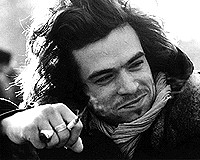When French director Tony Gatlif debuted Gadjo dilo at the 1997 Locarno Film Festival, 3000 viewers rose to their feet and delivered him a ten-minute ovation. The film was lauded by the festival-circuit critics, most of whom noted its emotional effect on Western audiences and who loaded their reviews with adjectives such as "authentic," "passionate," "visceral," "pulsating," and "full-blooded."
This film seemed to crown Gatlif's achievements as an interpreter of Romani (gypsy) culture, finally taking us beyond the stoop and right into bed with the fiddle-playing, horse-rustling, dark-skinned nomads lurking in their wagon camps on the fringes of Fortress Europe.
Gatlif, a prolific director over the past three decades, was born in 1948 of Roma and Algerian parents, and Gadjo dilo is the third film of his "gypsy triptych." Les princes (1982) depicted the harsh reality of life for Roma in a Paris suburb and Latcho drom (1993) was a feature-length documentary exploring global Roma culture through music and dance.
While the latter was hailed by some as "the most genuine film of 1993," and certainly contributed to the monumental growth in interest in world music at the time, only Gadjo dilo has managed to transcend the arthouse and appeal across the spectrum, receiving the "thumbs up" from the critics that exist to put bums on seats for Hollywood. It has everything: exotic location, sex in the forest, gyspy weddings, a bit of violence and lots of juicy lines from under-14s, such as: "eat my cock with polenta!"
Musical odyssey
Gadjo dilo follows the journey of a young French man, Stéphane, to a small Romani community on the outskirts of a Romanian village, guided by an old gyspy recording of his father's. Like in other works of this established genre (Razor's Edge, Sheltering Sky, Witness, Cold Fever), we are confronted with a refugee from our own, flawed cultures, seeking a sliver of truth in exotic and foreign surroundings, establishing contact with the "other" and preparing to return with his own pillaged treasure—an Elgin Marble to illuminate our lives.
Stéphane is searching for the music of Nora Luca. With his DAT recorder and his broken-down Dacia, he samples the songs and myths of Romania's Roma, accumulating a stack of neatly labelled cassettes for the return to Paris.
If we are truly caught in the headlights with this film, it is because Gatlif has abandoned the rarified documentary devices of his previous film and  given us a hook to hang our sympathies on. The most compelling moment of Latcho drom was a lament to the Ceauşescu period, performed by a husk of a man tugging a horse-hair along a violin string—a haunting sound, but only a sound. With Gadjo dilo, we are given in Stéphane a modern-day Virgil to punt our boat through the fascinating counter-culture of Romani life in modern Europe.
given us a hook to hang our sympathies on. The most compelling moment of Latcho drom was a lament to the Ceauşescu period, performed by a husk of a man tugging a horse-hair along a violin string—a haunting sound, but only a sound. With Gadjo dilo, we are given in Stéphane a modern-day Virgil to punt our boat through the fascinating counter-culture of Romani life in modern Europe.
In Stéphane, we recognise our own "orientalist" fascinations. Through his own awkward collisions within a Romani village, we get a hell of a ride ourselves, getting to watch this Frenchman have sex in a teepee, drink moonshine in the snow and plod around in a mud-dominated landscape without actually having to do it ourselves (really, pretty unhygienic).
Cultural clash
Stéphane wanders down a frozen road in the Romanian country-side—the endless, flat expanse of snow dominates—and, simultaneously, beguiling gypsy music begins as Stéphane, and the camera, begin to spin. We both spin—protagonist and viewer—the landscape blurs, and like a shamanic ecstasy, there is a transport to some other place. With disorientation comes a changing of the lense, a switch of terms of reference, and we step through the looking glass.
 It is important to note that Gatlif shot the film in the order that we see in the film, so that Romain Duris's (Stéphane) collision with Romani culture, and his integration into it, would be as natural as possible. Stéphane is adopted by a garrulous village patriarch—Isador—whose son has been been beaten, arrested and taken away by the police.
It is important to note that Gatlif shot the film in the order that we see in the film, so that Romain Duris's (Stéphane) collision with Romani culture, and his integration into it, would be as natural as possible. Stéphane is adopted by a garrulous village patriarch—Isador—whose son has been been beaten, arrested and taken away by the police.
While Stéphane remains obsessed with his search for the music of Nora Luca, Isador proudly parades his new find through Romani, and local Romanian, society—for him this is reflected glory. At first mistrusted by the community (called a chicken thief and a bum, in a lovely inversion of roles), he gradually integrates into village life, taking on its residents' mannerisms (spitting), their passions (gambling) and even their verbal dexterity (some stunning Romani cursing).
Naturally, Stepan and his adoptive community also develop mutual emotional attachments, and Sabina (Rona Hartner), a Magdelene figure ostracised for having left her husband, becomes a lover at the same time as she mediates between Stéphane and the Roma he records on his machine.
Stéphane's is a process of acculturation—he moves fully in the direction of Romani society and emulates its habits in order to gain access. In this sense his experience fused with the camera's eye purports to be an intimate discovery of the people behind the wall of stereotypes so robustly constructed around Romani culture. Gatlif's pedigree—half-Roma himself—assures us that this is a "true" picture.
The conscious use of documentary devices, what some critics have denounced as "poor editing," knock our natural filtering reflex back. Long takes, the obvious use of non-professional actors, primitive editing and static background activity—the whole neo-realist bag of tricks—easily create a sense of versimilitude with audiences steeped in the ultra-produced conventions of modern film-making.
Backlash
As the film runs on and Stepan becomes more and more a quotidian feature in the Romani village, there seems to be a narrowing of options, a relentless drive toward the tragic end that fits the setting. Just as Stéphane and Sabina make love in the forest where she was born, Isador's son Adriani returns from prison and incites a pogrom.
The Romanian villagers burn the Romani village, leading to the rapid-track shot of the community in flight: a potent symbol of the Romani identity and, considering the Romani belief in destiny, a fact of life.
Moreover, the tragedy is personal; the villagers burn Adriani as he hides from them in his attic. The image of the blackened and smoking Romani camp is  pungently emotive, and as Sabina and Stéphane discover Adriani's body, her shriek merges with the plaintive wail of a gypsy lament. Stéphane must confront the pornographic hypocrisy of his, and white culture's, relationship with these people: valued for their raw and intoxicating musical culture and yet feared and reviled as neighbors and fellow citizens.
pungently emotive, and as Sabina and Stéphane discover Adriani's body, her shriek merges with the plaintive wail of a gypsy lament. Stéphane must confront the pornographic hypocrisy of his, and white culture's, relationship with these people: valued for their raw and intoxicating musical culture and yet feared and reviled as neighbors and fellow citizens.
The West fails to triumph
Music is pleated into the final heart-rending scenes as if to reinforce its irreducible connection to the Romani tragedy: it is a reflection of pain and relief from suffering, and, like a heart, it dies when it is ripped out of the body. Stéphane, in a ritual learned from Isador, buries his DAT cassettes by the side of the road, sprinkles them with spirit and does a final, salutory dance. He turns his back on the architecture of the story the viewer is primed to expect and gives himself fully to his new community.
At this point, the viewer and his faithful guide part ways. In each cinema I have seen this film, at the point that Stéphane crushes his cassettes against a stone and throws them in the ground, the whispering begins. The horror of this waste is always palpable, and I, too, am saying, "No! Not the tapes!"
Stéphane betrays our hopes for him when he ruins the commodified product of his journey, and we lose touch. Whereas he mediated for the viewer while he still stood apart from the community, there to sample, quite literally, but not fully participate, he is no longer "ours" once he integrates.
There is a lot to say about the role Gatlif's film plays as a mediator between Western and Romani cultures, and it is certainly reasonable to contrast the two, given the gulf in understanding that separates them. The Roma remain the least integrated and the most persecuted people of Europe. Their recent history in Romania, where an estimated two million live, is particularly dark.
The more common criticisms of Gadjo dilo point to its negative portrayal of the Roma and the fear that such a depiction will make the idea of

|
This is not a documentary film nor is it necessarily a fiction. Gatlif has breathed heart and humanity into the statistics that should enrage us but which usually only bore us. This is Europe, after all, and these are the same Roma that clog our streets, clamouring for change.
The real danger was always that we would objectify these so outwardly foreign people in a way that suited our naturally insular instincts. A story such as this, with such narrative power and universal emotional resonance, brings us closer to a state of human empathy in a way that human rights law or EU propaganda never could. A pretty good argument for art as a moral force in our lives.
Niobe Thompson, 27 November 2000
Moving on:
- The Kinoeye Archive of articles on Central and East European film
- Buy English-language books on CEE film through CER
- Buy English-subtitled CEE films on VHS through CER
- Browse through the CER eBookstore for electronic books
- Return to CER front page



 Gulf
Gulf